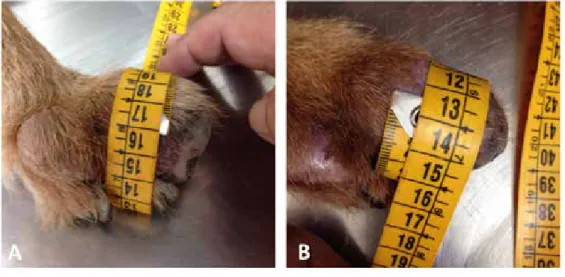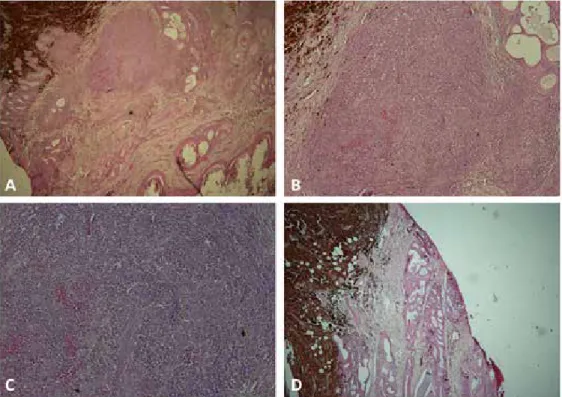KEY WORDS: dermal melanoma, nutraceutical diet, median survival time, QoL, elderly dog
ABSTRACT
The aim of this work was to evaluate the possible beneficial effects of a nutraceuti-cal diet on a careless dermal melanoma in an elderly dog. Hemato-biochemical and metabolic parameters as well as clinical symptoms evaluations were performed to monitor the possible improvements of the clinical picture of the dog following a nutraceutical diet supplementation. Hemato-biochemical analyzes and clinical symptoms before nutraceutical diet and after specific diet suspension showed an overall improve-ment. Moreover, no strong evidence of metastasis after radiographic investigations was observed.
This study suggests that clinical sta-tus and quality of life (QoL) of an elderly dog affected by dermal melanoma can be
positively influenced by a nutraceutical diet supplementation.
INTRODUCTION
Among canine skin tumors, cutaneous mela-nomas represent 0.8–2%.1 Multiple factors affect biological behavior and prognosis of the melanomas such as:
• tumor site,2
• the mitotic index (three or more mitotic figures per 10 high-powered fields indi-cate malignancy),3
• degree of pigmentation, • necrosis,
• ulceration,
• inflammation presence2
Most of cutaneous melanomas in dogs are benign, with a low mortality rate com-pared with those occurring in other districts such as eye, feet/digit and mucosa.4,5 Digit melanomas have an intermediate progno-sis and are generally benign. However, an
A Case of Canine Dermal Melanoma: A
Nutraceutical Approach
Sergio Canello
1Gianandrea Guidetti
2Alessandro Di Cerbo
3*
Raffaella Cocco
41Forza10 USA Corp., Research and Development Department, Orlando,
6450 Kingspointe Pkwy Orlando Fl 32819, USA; [email protected],
2Research and Development Department, SANYpet S.p.a., 35023 Bagnoli di Sopra,
Padua, Italy; E-mail. [email protected]
3Department of Medical, Oral and Biotechnological Sciences, Dental School,
University G. d`Annunzio of Chieti-Pescara, Chieti, Italy; E-mail [email protected]
4Department of Veterinary Medicine, Pathology and Veterinary Clinic Section,
University of Sassari, 07100 Sassari, Italy; E-mail. [email protected] (*) Corresponding author: Alessandro Di Cerbo,
Department of Medical, Oral and Biotechnological Sciences, Dental School, University G. D`Annunzio of Chieti-Pescara, Chieti, Italy;
epidemiologic survey from Spangler et al (2006) revealed that feet melanomas have a diagnosis of malignancy in 74% of the cases, a recurrence or possibility to metas-tasize of 38% and a median survival time of 158 days.
Elective treatments for melanomas are surgical excision or systemic chemotherapy.6 However, molecular targeted therapies, e.g, receptor tyrosine kinase (RTK) inhibitors,7 IFN-α 8, and cancer vaccines 9,10 have gained great attention.
To the best of our knowledge, this is the first case of an elderly dog treated with a commercially available nutraceutical diet for a right hind paw malignant melanoma. The nutraceutical diet consisted in a commercial mixed formula based on fish proteins, rice carbohydrates, Cucumis melo, Ascophyllum
nodosum, Hematococcus pluvialis, Aloe vera, Carica papaya, Punica granatum, Camellia sinensis, Polygonum cuspida-tum, Curcuma longa, Piper nigrum, zinc,
and a Omega3/6 ratio of 1:0.8, which was already proven to significantly decrease type 1 helper T lymphocyte (Th1) cells and increase T regulatory (Treg) cells in dogs affected by Leishmania infantum11, signifi-cantly improve clinical signs and symptoms of canine keratoconjunctivitis sicca 12 and exert a significant anti-inflammatory activity
in vitro.13
CASE PRESENTATION
On September 2014, a 13-years-old male mixed breed dog presented to the veterinary Hospital of the University of Sassari for treatment of asthenia, increased weight, and appetite loss.
Physical examination revealed bright-ness, poor responsiveness and altered vital parameters (T = 37.6 °C, P = 65 bpm, RR = 18 brpm). A 17 cm, haired mass raised over the dog’s right hind paw was noted (Figure 1).
A biopsy revealed malignant mela-noma with approximately 3 mitoses per 10 high-powered fields (HPF). Generally, mucocutaneous junctions and glabrous skin lesions refer to malignant forms, while the others are considered as benign. In this case the presence of atypical pleomorphic nuclei (multiple nucleoli) lay for a malignant form despite the low proliferative activity (Figure 2). The work-up for the dog also included hemato-biochemical and metabolic analysis, three-view thoracic radiographs, and ab-dominal ultrasound in order to obtain a base-line health status on the dog. Initial blood exam and serum proteins electrophoresis evidenced a slight lymphopenia (19.4%, ref. val. 25-50%) and an alfa2 and beta2
frac-Figure 1. Clinical pictures of right hind paw melanoma. (a) A 17 cm haired, stiff and
tions increase (16.4%, ref. val. 7.9-13.0%; 36.3%, ref. val. 11.5 - 23.2%; respectively). None of the metabolic profile parameters resulted altered.
In spite of the need for surgical excision of the mass to reduce the risk of metastasis, the advanced age, the low survival rate after a surgical intervention, and the previous un-successful pharmacological treatments come out in favor of a nutraceutical approach.
After 1 month of nutraceutical diet administration, a normalization of lympho-cytes was observed, while the alfa2 and beta2 fractions increase still persisted.
The same trend was observed after 3 months of nutraceutical diet supplementa-tion. After 5 months, the metabolic profile showed a total bilirubin and CPK increase (1.18 mg/dl, ref. val. 0.11- 0.31 mg/dl; 279 U/l, ref. val. 42-155 U/l; respectively), while a decrease of alfa1 (2.2%, ref. val. 2.6 - 4.5%) and an increase in alfa2, beta, and gamma were observed (14.0, ref. val.
7.9 - 13.0; 33.0%, ref. val. 11.5 - 23.2% and 14.6%, ref. val. 6.5 - 14.0%; respectively).
Due to the reduced metabolic require-ments of the dog, the nutraceutical diet was suspended and a specific diet for elderly dogs was administered. A further increase of CPK, creatinine, P, GOT, and Mg was observed (540 U/l, ref. val. 42-155 U/l; 1.69 mg/dl ref. val. 0.8- 1.42 mg/dl; 11.3 mg/dl, ref. val. 2- 3.5 mg/dl; 82 U/l ref. val. 21-44 U/l; 2.35 mg/dl ref. val. 0.67-0.94 mg/dl; respectively). Hence, the diet was suspended and the nutraceutical diet reintroduced. After 3 months CPK, creatinine, P, GOT, and Mg resulted decreased within normal range.
The three-view radiographs were clini-cally normal and negative for metastasis. The abdominal ultrasound revealed a dif-fusely, mildly enlarged spleen with normal echogenicity. Based on these findings, there was no strong evidence of metastasis and overall the dog appeared to be in good health.
Figure 2. Photomicrograph of right hind paw melanoma. Presence of atypical pleomorphic
Physical exams and diagnostic tests were also repeated 6, 12 and 24 months since nutraceutical diet supplementation begin.
Unfortunately, after 26 months since nutraceutical diet supplementation, the dog died due to a rapid worsening of clinical picture.
DISCUSSION
The initial lymphopenia might be ascribed to the right hind paw lesion. In fact, it is typical of an acute inflammatory status or infec-tions, mostly viral. The metabolic profile did not evidence any alteration. Therefore, the appetite loss, the consequent slimming and asthenia, as well as the breath frequency in-crease might be the consequence of the pain/ complaint derived by the lesion. Physical exam did not show any alteration of the car-diocirculatory and respiratory system. Also, the increase of alfa2 globulins might be referred to the presence of the lesion, while the increase of beta globulins was linked to the overall inflammatory status.
The significant reduction of the lesion dimensions (~24%) was a clear evidence of the anti-inflammatory activity exerted by the nutraceutical diet 14,15, as well as the normal-ization of the blood exam and appetite. After 5 months, the reduction of blood cells count and hemoglobin and the increase of bilirubin addressed toward the diagnosis of hemolytic anemia.
The metabolic parameters variations led to a suspension of the nutraceutical diet due to its metabolizable energy content, which was higher with respect to that recommend-ed for an elderly dog. The new hemato-biochemical analyzes revealed the onset of a kidney insufficiency, preannounced by clini-cal symptoms such as appetite loss, polyuria, and polydipsia. Therefore, the nutraceutical diet was reintroduced. After 3 months, all hematological parameters resulted improved along with clinical symptoms, thus demon-strating the good tolerability of the diet de-spite the high metabolizable energy content.
In conclusion, the introduction of a nutraceutical diet resulted particularly
effec-tive in extending the median survival time of an elderly dog right hind paw melanoma, improving the hematological parameters and related clinical symptoms and consequently the QoL.
STATEMENT OF AUTHORSHIP
The authors hereby certify that all work con-tained in this article is original. The authors claim full responsibility for the contents of the article.
CONFLICT-OF-INTEREST STATEMENT The authors certify that there is no conflict of interest with any financial organization regarding the material discussed in the manuscript. This research was performed in collaboration with some scientists from the Division of Research and Development, Sanypet SpA, Padua, Italy (as indicated in the Author’s affiliation) according to scien-tific and ethical principles of the scienscien-tific community.
REFERENCES
1. Conroy JD. Canine skin tumours. J Am Anim Hosp
Assoc. 1983;19:91–114.
2. Liu W, Bennett M, Helm T. Canine melanoma: a comparison with human pigmented epithelioid melanocytoma. Int J Dermatol. 2011;50(12):1542-1545.
3. Goldschmidt MH. Histological Classification of
Epithelial and Melanocytic Tumors of the Skin of Domestic Animals. Armed Forces Institute of
Pathology; 1998.
4. Bosenberg M, Arnheiter H, Kelsh R. Melanoma in mankind’s best friend. Pigment Cell Melanoma
Res. 2014;27(1):1.
5. Spangler WL, Kass PH. The histologic and epi-demiologic bases for prognostic considerations in canine melanocytic neoplasia. Vet Pathol. 2006;43(2):136-149.
6. Bongiovanni L, D’Andrea A, Porcellato I, et al. Ca-nine cutaneous melanocytic tumours: significance of beta-catenin and survivin immunohistochemical expression. Vet Dermatol. 2015;26(4):270-e259. 7. Martin PD, Argyle DJ. Advances in the management
of skin cancer. Vet Dermatol. 2013;24(1):173-180 e138.
8. Kruth SA. Biological response modifiers: interfer-ons, interleukins, recombinant products, liposomal products. Vet Clin North Am Small Anim Pract. 1998;28(2):269-295.
9. Milner RJ, Salute M, Crawford C, Abbot JR, Farese J. The immune response to disialoganglioside GD3 vaccination in normal dogs: a melanoma surface antigen vaccine. Vet Immunol Immunopathol.
10. Chapman PB, Wu D, Ragupathi G, et al. Sequential immunization of melanoma patients with GD3 ganglioside vaccine and anti-idiotypic monoclo-nal antibody that mimics GD3 ganglioside. Clin
Cancer Res. 2004;10(14):4717-4723.
11. Cortese L, Annunziatella M, Palatucci AT, et al. An immune-modulating diet increases the regulatory T cells and reduces T helper 1 inflammatory response in Leishmaniosis affected dogs treated with stan-dard therapy. BMC Vet Res. 2015;11(1):295. 12. Destefanis S, Giretto D, Muscolo MC, et al.
Clini-cal evaluation of a nutraceutiClini-cal diet as an adjuvant to pharmacological treatment in dogs affected by Keratoconjunctivitis sicca. BMC Vet Res. 2016;12(1):214.
13. Guidetti G, Di Cerbo A, Giovazzino A, et al. In Vitro Effects of Some Botanicals with Anti-In-flammatory and Antitoxic Activity. J Immunol Res. 2016;2016:5457010.
14. Di Cerbo A, Centenaro S, Beribe F, et al. Clinical evaluation of an antiinflammatory and antioxidant diet effect in 30 dogs affected by chronic otitis externa: preliminary results. Vet Res Commun. 2016;40(1):29-38.
15. Di Cerbo A, Morales-Medina JC, Palmieri B, et al. Functional foods in pet nutrition: Focus on dogs and cats. Res Vet Sci. 2017;112:161-166.

